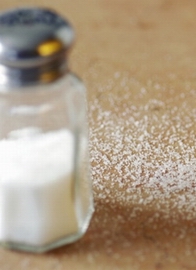 alt and lime with tequila. Salt with your iced "michelada" beer. Salt and chili on fruit and even candy. Mexicans love salt, so much so that some estimates show them eating nearly three times the recommended amount and significantly more than what Americans put down.
alt and lime with tequila. Salt with your iced "michelada" beer. Salt and chili on fruit and even candy. Mexicans love salt, so much so that some estimates show them eating nearly three times the recommended amount and significantly more than what Americans put down.Add this to rising obesity and a hypertension epidemic, and you have a potential health nightmare that has spurred Mexico’s massive capital city to try to get residents to shun the salt shaker.
Mexico City Health Secretary Armando Ahued launched a campaign, dubbed "Less Salt, More Health," earlier this month to get restaurants to take salt shakers off their tables. Officials and the city’s restaurant chamber signed an agreement to encourage eateries to provide shakers only if guests ask for them. The program is voluntary but the chamber is urging its members to comply.
The anti-salt campaign is part of a growing wave of activism by mayors such as New York City’s Michael Bloomberg , whose administration has nudged food manufacturers to reduce salt and promulgated voluntary salt guidelines in 2010 for various restaurant and store-bought foods. Bloomberg has also tried to cap the size of non-diet sodas and other sugary drinks, but a court struck down the beverage rule just before it was to take effect last month. The city is appealing.
In Mexico City, only a minority of restaurants appear to have joined the campaign in its first few days, but some are complying, including El Estragon restaurant in the touristy Juarez neighborhood, where manager Isabel Santiago said it has taken shakers off the tables.
"It is for the good of the customers. We have to look after them," Santiago said. "It’s in our own best interest" to keep customers alive and eating as long as possible.
At a street stand in downtown Mexico City, lanky law student Alejandro Alfaro paused before diving into a plate of cecina tacos, a chili-laden dish of salted meat, to sprinkle on more salt from a shaker.
"This is a normal thing," Alfaro said a little guiltily as he tucked into the tacos. "Your body needs all sorts of nutrients."
That is precisely the sort of salt-on-top-of-salt that the campaign is targeting in Mexico City, where people often sprinkle salt-and-chili powder onto already salted potato chips. Bags of apples sometimes contain plastic packages of salty vinegar-and-chili salsa.
"Salt is such an ingrained part of the Mexican food experience," said Lesley Tellez, who leads street food and market tours in Mexico City with her company, Eat Mexico. "Salsas don’t taste the same without it, and neither does mole or even a fresh corn tortilla, let alone fruit with salt and chili powder!"
While the battle may appear uphill, Mexico City’s top health official says it is worthwhile since excess salt consumption is believed to raise blood pressure and cause hypertension. Two-thirds of two-thirds of Mexican adults are overweight or obese, and diabetes and hypertension are reaching epidemic proportions.
Ahued says many Mexicans regularly consume as much as 11,000 milligrams of salt per day, which would translate to 4,400 milligrams of sodium. Carlos Hoyo Vadillo, a researcher at Mexico’s Center for Advanced Studies and Research, places Mexico’s salt intake at 10,000. That’s still well above the 3,436 milligrams of sodium the Center for Disease Control estimates as the U.S. daily intake, which in turn is still far above the recommended 1,500 to 2,300 milligram maximum per day.
Why So Much Salt?

Mexico is a big salt producer, and is also being hit by a double whammy: salt coming from American-style processed foods that have grown in popularity and the country’s own longstanding, home-grown love affair with the combination of lime, chili and salt - Mexico’s "umami" if you will.
Mexicans’ taste for salt begins at a young age, with children savoring tamarind or dried mango candy coated with chili powder and salt. Vendors hover outside schools selling potato and banana chips, offering to sprinkle a salt-and-chili mixture on top. Chamoyada paste and Valentina sauce are put on fruits and snacks almost by habit.
Among adults, a well-prepared margarita must have a rim of salt on the glass, and on a hot summer day, nothing goes down smoother than a "michelada" beer with ice, lime and a thick coating of salt around the lip of the glass.
"Mexicans like strong flavors and that’s why it’s very common to combine lime and salt, but all the foods like pizza and ham already have a big dose of salt," Hoyo Vadillo wrote.
At least a few countries top Mexico in salt consumption, notably in Asian nations with a taste for miso broths, pickled vegetables and salt-laden soy sauces.
But Julian Alcala, a professor of public health at Mexico’s National Autonomous University, says that while it is a world problem, salt hits Mexico particularly hard. "It is an ancestral problem. In Mexico, there are even beautiful stories about the (pre-Hispanic) salt goddess."
Alcala said the problem is aggravated by the processed, industrialized foods Mexicans began consuming in recent decades. "It is much more complicated than just saying: ’take the salt off the table.’"
"They have to stop selling us the garbage they’re selling us," he said of food companies.
Back in Juarez neighborhood, Rocio Perez, the manager of Antojitos Mexicanos restaurant, chatted with customers and watched as waiters dispatched endless tacos de guisado at tables still laden with salt shakers.
"You have to give the customers what they want," Perez said. "There are a lot of people who, before they even try the food, they’re already sprinkling salt on it. These tastes aren’t going to change."
Consumer activist Alejandro Calvillo said the Mexico City campaign is a worthy effort, but falls short by not confronting the major snack vendors.
It’s an issue that Mexico, which now holds the dubious distinction of being the world’s biggest per-capita consumer of soft drinks, has faced before. Repeated campaigns to wean Mexicans off soft drinks and junk food have failed.
Calvillo and others hope the anti-salt campaign doesn’t go the same way.
"We think it’s good, but it doesn’t address the main cause of high salt consumption, which is the processed foods," Calvillo said. "In the cases both of salt consumption and obesity, public policies have been designed with conflicts of interest, because of the participation of companies that caused the problem in the first place."





